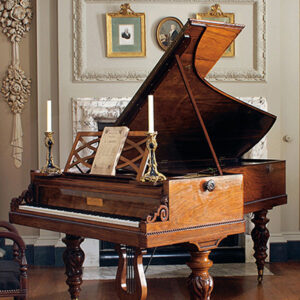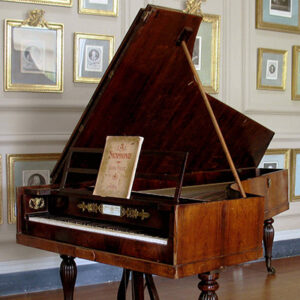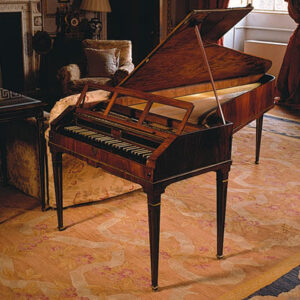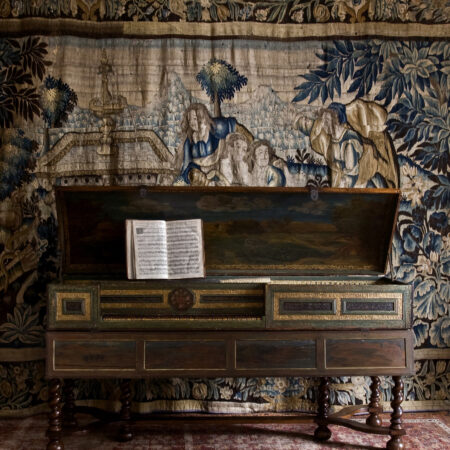Musical Instruments
The keyboard repertoire comprises one third of the whole of Western music. The very instruments chosen by composers themselves form the heart of The Cobbe Collection at Hatchlands. The eighteen owned or played by Purcell, Johann Christian Bach, Mozart, Haydn, Beethoven, Chopin, Mahler and Elgar, to name a few, are the largest group assembled anywhere of these tangible and audible relics connecting with the musical minds of the past. The collection otherwise comprises a further twenty or so instruments that were chosen to represent instrument-makers who were highly regarded or patronised by composers, all maintained in playing order. Here you can learn more and listen to each instrument. The music examples are played by David Owen Norris, Oliver Davies, Sam Haywood and Alec Cobbe.
-
SAXON PIANO
by Ferdinand Weber, Dublin, 1774
-
RUSSIAN GRAND PIANO
by Jakob Becker, St Petersburg, c.1886-7. Belonged to Sir Percy Hull
-
ENGLISH HARPSICHORD
by Jacob & Abraham Kirkman, London, 1781
-
SAXON HARPSICHORD
by Ferdinand Weber, London, 1746
-
ENGLISH PIANO
by Longman & Broderip, London, c. 1789
-
HAYDN’S GRAND PIANO
by Longman & Broderip, London, 1794-95 with a compass of 5½ octaves
-
SPANISH OR PORTUGUESE CLAVICHORD
unknown maker c. 1750-75
-
BIZET’S COMPOSING TABLE PIANO
by Roller of Paris, 1855
-
ORGAN
by J.W. Walker & Sons Ltd., London, 1903
-
LISZT’S ITALIAN UPRIGHT PIANO
by Carlo Ducci, Florence, between 1873 and 1886
-
AMERICAN GRAND PIANO
by Steinway, New York, c. 1864
-
CHOPIN’S ENGLISH GRAND PIANO
by John Broadwood & Sons, London, 1847 Chosen by Chopin for his English recitals
-
CHOPIN’S ‘OWN’ GRAND PIANO
No. 13819, by Pleyel & Compagnie, Paris, 1848
-
LADY JOHN SCOTT’S GRAND PIANO
by Erard, Paris, 1845. Performed upon by Thalberg
-
ELGAR’S PIANO
by John Broadwood and Sons, London, 1844
-
JANE STIRLING’S GRAND PIANO
by Erard, London, 1843
Possibly given to Chopin in 1848 -
MAHLER’S GRAND PIANO
by Conrad Graf, Vienna, c. 1836
-
GEORGE IV’S GRAND PIANO
by Nannette Streicher, Vienna, 1823
-
VIENNESE GRAND PIANO
by Conrad Graf, Vienna, c. 1819-20, with quadruple stringing
-
CRAMER’S GRAND PIANO
by John Broadwood and Sons, London, 1816 Performed upon and signed by J.B. Cramer
-
VIENNESE GRAND PIANO
by Anton Walter and Son, Vienna, c. 1815
-
ENGLISH PIANO
by John Broadwood and Son, London, 1795
-
ENGLISH GRAND PIANO
by Longman & Broderip, London, c. 1795 with a compass of 5½ octaves.
-
ENGLISH PIANO
by John Bland, London, 1794
-
IRISH PIANO
by William Southwell, Dublin, c. 1793-94 with a compass of 5½ octaves
-
VIENNESE GRAND PIANO
circle of Johann Andreas Stein, Vienna, C.1790
-
GRAND PIANO WARRANTED BY DIBDIN
by Crang Hancock, London, c. 1790
-
MARIE ANTOINETTE’S PIANO
by Sébastien Erard, Paris, 1786-87
-
SAXON CLAVICHORD
by Christian Gotthelf Hoffmann, Ronneburg, 1784
-
‘DECEPTION PIER-TABLE PIANO FORTE’
in the form of a metamorphic half-moon table by William Southwell, Dublin c. 1785
-
SAXON SPINET
by Ferdinand Weber, Dublin, 1780
-
JOHANN CHRISTIAN BACH’S PIANO
by Johannes Zumpe & Gabriel Buntebart, London, 1777-78
-
ENGLISH PIANO
by Johannes Zumpe and Gabriel Buntebart, London, 1769
-
CHAMBER ORGAN
by John Snetzler, London, 1759
-
KING CHARLES II’s VIRGINALS
by John Player, London, 1664
-
FLEMISH HARPSICHORD
by Andreas Ruckers, Antwerp, 1636. Ravalement by Henri Hemsch, Paris, 1763
-
ENGLISH HARPSICHORD
Dated 1623 but mostly dating from c. 1720
-
ITALIAN HARPSICHORD
attributed to Girolamo Zenti, Viterbo, signed GZ 1622
-
ITALIAN VIRGINALS
by Annibale or Ferrante Rossi, c.1550-80






































